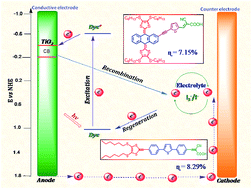Recent developments in tetrathiafulvalene and dithiafulvalene based metal-free organic sensitizers for dye-sensitized solar cells: a mini-review†
Abstract
Currently, there is a great need for green and clean energy sources to meet the needs of the ever-increasing population in the world. Consequently, scientists across the globe are paying much attention to the development of low cost and high performance renewable energy devices. Dye-sensitized solar cells (DSSCs) are the front-runners among new solar cell technologies owing to their low production cost and high efficiency. Dyes (sensitizers) are one of the essential components of DSSC devices in which the widely used sensitizers are Ru(II) polypyridyl complexes. Despite the fact that Ru(II) polypyridyl complexes show high efficiency, they have limitations due to technical constrains. Hence, research has been accelerated in the design and synthesis of various dyes based on non-ruthenium metal complexes, porphyrins, phthalocyanines and metal-free organic compounds. In recent years, tetrathiafulvalenes (TTFs), dithiafulvalenes (DTFs) and their derivatives have been found to be best alternatives to Ru(II) polypyridyl complexes based on their easy synthesis, and electronic and thermal properties. In this review, we summarize the recent progress in metal-free organic dyes using TTF and DTF scaffolds for dye-sensitized solar cells. The physical properties of devices can be tuned via the strategic design of sensitizers, which in turn help in increasing the performance of the devices. Herein, special attention is paid to correlate the structure activity relationship of the components of D–π–A systems to gain insight into the efficient design strategies.



 Please wait while we load your content...
Please wait while we load your content...